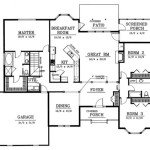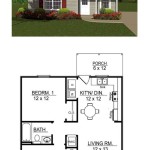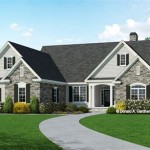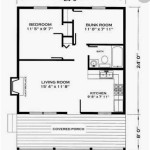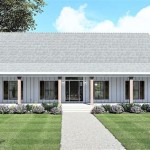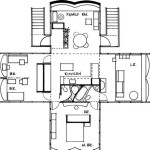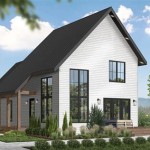Basic House Floor Plan Dimensions: A Comprehensive Guide
Understanding standard house dimensions is crucial for effective space planning and creating a functional home. Whether building a new home or renovating an existing one, having a grasp of typical room sizes and circulation spaces can significantly impact the overall livability and comfort of the residence.
Key Dimensions for Living Spaces
Living rooms serve as the central gathering space in most homes. Comfortable seating arrangements and adequate circulation flow are primary considerations when determining dimensions. Typical living room sizes range from 12 feet by 15 feet to 15 feet by 20 feet. Smaller homes or apartments might have living rooms as compact as 10 feet by 12 feet. Larger homes may feature living rooms exceeding 20 feet in length or width.
Dining Room Dimensions
Dining rooms should comfortably accommodate dining furniture and allow for easy movement around the table. A rectangular table for six people typically requires a space of at least 10 feet by 12 feet. For larger gatherings, a room measuring 12 feet by 14 feet or more is recommended to prevent overcrowding. Smaller, more casual dining areas can function effectively in spaces as compact as 8 feet by 10 feet.
Kitchen Planning and Dimensions
Kitchen layouts significantly impact functionality and workflow. The “kitchen work triangle” connects the sink, refrigerator, and range. This triangle's perimeter ideally ranges between 12 and 26 feet. A single-wall kitchen layout might be as narrow as 8 feet wide, while U-shaped or L-shaped kitchens often require a width of 10 to 12 feet. Island kitchens necessitate additional space, typically adding 3 to 4 feet to the overall width.
Bedroom Size Considerations
Master bedrooms should comfortably accommodate a king-size bed, nightstands, and dressers. A minimum size of 12 feet by 12 feet is recommended, while larger master suites can range from 14 feet by 16 feet to 20 feet by 20 feet. Standard bedrooms typically measure between 10 feet by 10 feet and 12 feet by 12 feet, providing sufficient space for a queen or full-size bed and other essential furniture.
Bathroom Dimensions and Layout
Bathroom sizes vary based on the fixtures included. A full bathroom containing a sink, toilet, and bathtub/shower combination requires a minimum of 5 feet by 8 feet. Larger bathrooms, including separate showers and bathtubs, can range from 8 feet by 10 feet to 10 feet by 12 feet. Half-bathrooms, containing only a sink and toilet, can be as small as 3 feet by 6 feet.
Hallway and Circulation Space
Hallways and circulation spaces ensure easy movement between rooms. A minimum hallway width of 3 feet is recommended for comfortable passage. Hallways leading to bedrooms or other frequently used areas may be wider, up to 4 or 5 feet, to accommodate multiple people passing simultaneously. Adequate hallway width is crucial for accessibility and preventing a cramped feeling within the home.
Ceiling Height Standards
Standard ceiling heights are typically 8 feet. Higher ceilings, ranging from 9 to 10 feet, create a sense of spaciousness and can enhance the overall aesthetic appeal. In some architectural styles, ceiling heights may exceed 10 feet, adding a dramatic element to the space. Local building codes often dictate minimum ceiling heights, so consulting these regulations is essential during the planning process.
Garage Dimensions and Functionality
Garage dimensions depend on the number of vehicles housed and the intended use of the space. A single-car garage typically measures 12 feet wide by 20 feet deep. A two-car garage requires a minimum width of 20 feet and a depth of 20 feet. Larger garages, accommodating three or more vehicles, will require proportionally greater dimensions. Additional space for storage or workshops should be considered in the overall garage dimensions.
Door and Window Standard Sizes
Standard interior door heights are typically 6 feet 8 inches. Door widths vary depending on the location and purpose, with common sizes ranging from 2 feet 6 inches for bedrooms and bathrooms to 3 feet for main entryways. Standard window sizes also vary, but commonly used dimensions include 3 feet by 5 feet, 4 feet by 4 feet, and 6 feet by 6 feet. These sizes can be adjusted to suit specific design requirements and optimize natural light within the home.

12 Examples Of Floor Plans With Dimensions

A Floorplan Of Single Family House All Dimensions In Meters Scientific Diagram

House Plans How To Design Your Home Plan

Floor Plans With Dimensions Including Examples Cedreo

How To Read A Floor Plan With Dimensions Houseplans Blog Com

Floor Plans With Dimensions Including Examples Cedreo

Floor Plan With Dimensions Guide To Drawings Small House Blueprints Design Pictures

Floor Plan With Dimensions 1 One House Plans Bungalow Cottage

The Ground Floor Of House Layout And Dimensions In Cm Scientific Diagram

How To Read Floor Plans

